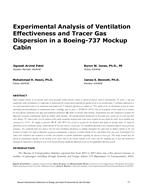Description
High occupant density in an aircraft cabin raises passenger health concerns related to spread of diseases and/or contaminants. To ensure a safe and comfortable cabin environment it is imperative to understand the various factors affecting the quality of air in an aircraft cabin. Ventilation effectiveness is one such factor which needs to be understood and studied well. Ventilation effectiveness is defined as “The ability of the air distribution system to remove internally generated pollutants or contaminants from a building, zone or space” (ASHRAE 2013). One of the purposes of this study was to evaluate the local effective ventilation rates (eL) and ventilation effectiveness (E) inside an aircraft cabin mockup. Experiments were also conducted to examine the dispersion of gaseous contaminants inside an airliner cabin mockup. All experimentation documented in this paper was carried out in a five-row, fullscale, Boeing 737 cabin section. For the purpose of this study, manikins wrapped with heater wires occupied all seats inside the cabin. Each manikin was connected to a 115V AC supply to generate 100 W (341 BTU/hr) of heat to account for the thermal load inside an aircraft cabin. To study the effectiveness of the ventilation system, carbon dioxide (CO2) was used as a tracer gas. The ventilation effectiveness was evaluated using the tracer gas decay technique. The conclusion from this study is that the local ventilation effectiveness is uniform throughout the cabin with no distinct relation to the seat locations or height. For study of dispersion of gaseous contaminants, a mixture of carbon dioxide (CO2) and helium (He) was used. Normalized CO2 values were calculated and examined at various seat locations to provide information regarding the spread of tracer gas. This study revealed that the spread of contaminants depends on the location of the source and on the relative location of the source and the sampling seat. It was also found that although the dispersion is intended to occur in the lateral direction significant dispersion occurs in the longitudinal direction as well.
Citation: Second International Conference on Energy and Indoor Environment for Hot Climates, Doha, Qatar, February 2017
Product Details
- Published:
- 2017
- Number of Pages:
- 8
- Units of Measure:
- Dual
- File Size:
- 1 file , 920 KB
- Product Code(s):
- D-HCC17-10




